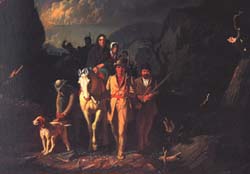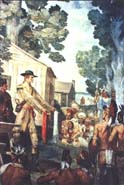
 |
The Americans (1778-1832) Daniel Boone leading American settlers westward across the Appalachians to colonize Indian hunting grounds in Kentucky. (oil on canvas by George Caleb Bingham) |
Whereas from a variety of unfortunate circumstances the several tribes of Illinois Indians are reduced to a very small number, the remains of which have been long consolidated and known by the name of the Kaskaskia tribe, and finding themselves unable to occupy the extensive tract of country which of right belongs to them and which was possessed by their ancestors for many generations, the chiefs and warriors of the said tribe...relinquish and cede to the United States all the lands in the Illinois country, which the said tribe has heretofore possessed. (Treaty between the United States of America and the Kaskaskia Tribe of Indians, 1803)![]()
![]()
![]()
![]()
In 1776, Great Britain's thirteen American colonies declared themselves independent and began a revolutionary war. Although many of the war's key battles took place east of the Allegheny Mountains, the fate of the Mississippi and Ohio valleys was determined by frontier settlers who had crossed the Alleghenies and were living in Virginia's newly formed county of Kentucky. Indian raids instigated by British leaders at Detroit (Michigan) were threatening the survival of these settlements. Patrick Henry, the governor of Virginia, appointed a young frontiersman named George Rogers Clark to command a militia intent on protecting the Kentucky settlements and capturing British strongholds in the Illinois Country.
![]()
![]()
George Rogers Clark speaking to American Indians at Cahokia, c1778.
In 1778, Clark organized a militia of 175 men and moved them in keelboats down the Ohio River to Fort Massac, an abandoned French fort in southern Illinois. From there he launched an overland march and, in a surprise attack, captured the British commandant at Kaskaskia. After securing the French settlements of Prairie du Rocher, St. Phillippe, and Cahokia, Clark established peaceful relations with local Illinois Indians of the Kaskaskia, Peoria, and Michigamea tribes. The chief of the Kaskaskia tribe, Jean-Baptiste Ducoign, became a loyal ally of the Americans and helped their cause by supplying them with men who served as hunters, scouts, and warriors.
The terms of America's victory over Great Britain in the Revolutionary War were established in the 1783 Treaty of Paris. By treaty, the United States took possession of most of the land that had been British territory east of the Mississippi River and south of the Great Lakes. Indian tribes living north and west of the Ohio River disputed American claims to this vast region. A series of battles occurred, ending in General Anthony Wayne's 1794 victory over a confederacy of tribes at the Battle of Fallen Timbers in northwestern Ohio. The Treaty of Greenville, signed the following summer by the Kaskaskia and other tribes, opened parts of present Ohio, Indiana, and Illinois to American settlement.
At the beginning of the 1800s, the Illinois Indians had been reduced to a population of only about 500 people. Of these, twenty families affiliated with the Kaskaskia tribe were living in a village near the town of Kaskaskia. The others, which included about five families of the Cahokia tribe and 100 families of the Peoria tribe, had moved to Spanish territory west of the Mississippi River. In 1803, the Kaskaskia tribe signed a treaty giving up its land claims in the present State of Illinois in exchange for two small reservations on the Kaskaskia and Big Muddy rivers. The Peoria, in turn, ceded their Illinois claims in a separate treaty signed in 1818. Finally, in 1832, two years after President Andrew Jackson signed the Indian Removal Act, the Kaskaskia and Peoria tribes agreed to merge and moved west to a reservation in Kansas.![]()
|
|
Copyright © 2000 Illinois State Museum
